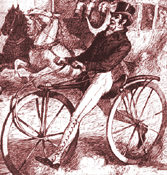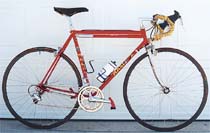 Classic Corner
Classic Cornercycling utah April 2000
 Classic Corner
Classic CornerGreat debate: What determines a perfect ride?
By Greg Overton
Been chatting with pals a lot lately on the ride characteristics of different frames and frame materials. What makes a great bike and how should one ride?
We talk about geometry and tubing thickness and fork rake, and what the pros ride, and what we like, and yadda yadda yadda, as though we know a lot about the subject. We talk about these things when we are riding, or when we are doing some bench racing or reminiscing about "THE GOOD OLE DAYS."
So I've got all this in my head when Ed. Bob calls and yells something about "meeting your deadline or else!" ... or something. It was just about that time, or just after, that the idea came for this month's Classic Corner. Funny how an idea is always just about to happen when Ed. Bob calls and screams.
Anyway, the idea was to "listen" to several of the most respected frame builders and get their opinions on what makes a good bike. There are some definite opinions on frame tubing and the virtues and weaknesses, and marketing B.S. that goes into regarding these.
But those opinions are going to be omitted here. You see we have friends whose families rely on the buying public to purchase what XYZ bike company sends them to sell. And if they hear "well so and so said this tubing sucks!" then yours truly may take a dip in the Jordan River wearing a pair of concrete Northwaves. Then Ed. Bob would have no one to scream at!

Following are quotes either from previous interviews or conversations regarding frame geometry, brazing and ride characteristics from some of the most respected names in frame building. We'll start with comments on frame geometry.
"Big strong riders have upright seat angles. But smaller, more agile riders need to be stretched out. I don't vary the head angle much. An upright angle does not descend well. "I focus on set back - the distance from the center of the bottom bracket to the seat lug center, measured horizontally." - Ugo DeRosa.
"I prefer a very low bottom bracket. It adds stability. I personally don't see why 'the lower the better' is not the rule of thumb. If you have to pedal through tight corners, you're cornering wrong. I also pay a lot of attention to seat tube angle" - Richard Sachs
"The 'classic' Italian racing frame is the result of decades of trying new things over and over. Each phase is followed by a return to traditional style and geometry. This is proven as the best combination of stability, performance and ride quality. Shallower angles and lower bottom brackets enhance a rider's ability to perform day in and day out on any terrain or surface." - Giovanni Pinarello
"I need to know the seat tube length, top tube length, and the offset - or seat tube angle. By offset, I mean the horizontal distance from the bottom bracket to the seat tube/top tube junction." - Roland Della Santa
"Road racing geometry is pretty refined stuff. You could take a ten-year-old Italian road bike and win the Tour today. If you didn't, it's not the frame's fault." - Keith Bontrager
"I start with the rider and tailor the bike, but bottom bracket height and seat angle are most important. I mix and match tubes to the rider's style and size, and I take great time and care in preparation. All this contributes, but individually does not make the bike considerably better." - Peter Weigle
Well that clears that subject right up! There was no mention of head angles or fork rakes or chainstay lengths. The consensus seems to center around seat tube angle. There was mention of frame tubes, but mostly what NOT to use. No one seemed to have a clear choice as long as the quality was there to begin with.
Now let's listen in on some construction tips.
"The brazing and alignment - making the frame free of defects - that's the grey area of frame building that can't be quantified on a computer. If you put the tubes together in the proper sequence, then it enhances the ride, because no matter how good the bike design is, it would not be right if not built straight." - Richard Sachs
"Silver brazing is the key. It has a lower brazing temperature, which gives the frame a much longer life span and leaves more ductility in the frame for a more compliant ride quality." - Brian Baylis
"A lot of people talk about brazing frames with silver. I think that's bunk. It's too expensive and the Asians have proven that it does not defray the fatiguing of a frame. I have fewer problems with brass." - Bill Davidson
"I prefer to use silver in the larger, tighter fitting joints. But brass fills gaps better in areas such as the dropouts and stays, but the key is to pin and tack the frame initially." - Peter Weigle
There would be more on this, but it is more of the same comments. Clearly there is no great conclusion here. Both methods seem to work fine, the key being the alignment and sequence of the build.
So where does this lead? How about the ride quality and the factors that contribute to the ride?
"The bicycle should do three things. First it holds the rider, which is the most important component, so it should hold him in the proper position to make him most efficient. Second, the bike must be stable and react properly under racing conditions. Finally, it should be efficient. That is, pedaling energy should be immediately transferred to the rear wheel." - Faliero Masi
"Rigidity is the most important factor, but not the only factor, as some modern bikes would have you believe. If rigidity comes at the cost of ride comfort and stability, it is too much rigidity! If this were easily perfected, we would stop trying materials and designs." - Ernesto Colnago
"The bike must perform in a predictable, stable manner, always the same no matter the road surface or the rider's level of fatigue. After that, any changes are purely aesthetic." - Cino Cinelli
"The racing bicycle is derived from practical principles! You need to be comfortable on the bicycle, whether you are riding a short distance or a long one. You can't go as well if the ride is unpleasant...you cannot win the race if you cannot finish the race." - Alcide Basso
Now, admittedly, these comments are only a drop in the lake relative to the number of frame builders out there. We tried to get a sampling from builders who are known to create great bikes and have been doing it or did it for a long enough time to see trends come and go.
Will this end the discussions and arguments with our pals? Are you crazy? Oh, and on the subject of frame tubing, make mine Reynolds 753.
 Back to Home Page
Back to Home Page